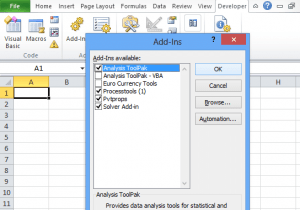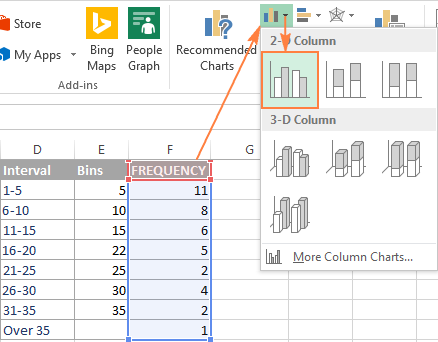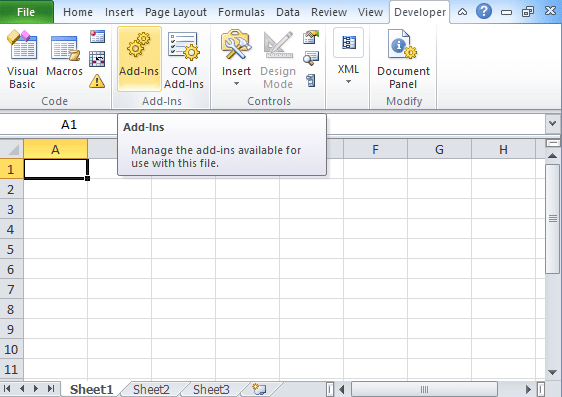
- FORMAT BIN RANGES FOR HISTOGRAM IN EXCEL ON MAC CODE
- FORMAT BIN RANGES FOR HISTOGRAM IN EXCEL ON MAC DOWNLOAD
- FORMAT BIN RANGES FOR HISTOGRAM IN EXCEL ON MAC WINDOWS
Cell F4 displays the minimum values in the same range. Notice it displays the maximum values within the data range named. As the Bin Count changes, different rows are used in the Chart Data box.Ĭlick on cell F5. Notice that when the slider is moved, the Bin Count and Bin Size (B5 and B6) changes,Īs well as data with the “Chart Data” box.
FORMAT BIN RANGES FOR HISTOGRAM IN EXCEL ON MAC CODE
(This spreasheet contains only functions and no VBA macro code which trigger scary messages when loaded.)ĭrag the slider all the way right to see the most number of columns (10 columns), which is a good segmeentation for our base-10 numbering system.ĭata in the sample spreadsheet are ages in a human population, which has a known range of values.Ĭells C4 and C5 (0 and 120) display those minimum and maximum values of bars in the Histogram.īTW, this is why someone around 60 years old is called “Middle Aged”.ĭrag the slider all the way left to see the least number of columns (just 2 columns), which basically divides the population by half according to the range between 0 and 120, which is 60. The Excel sheet is from/described here, based on Jon Peltier’s techniques:Ĭolored cells are where values and formulas are changed for alternate data. It contains a pre-made histogram which you don’t have to construct from scratch.
FORMAT BIN RANGES FOR HISTOGRAM IN EXCEL ON MAC DOWNLOAD
My favorite approach is to change a pre-defined spreadsheet which includes coding to provide a dynamic slider to control how many bins are shown:Ĭlick to download the Histogram-Dynamic.xls Excel file at: Throughout this page are “PROTIP” flags that highlight advice from experience not available elsewhere.
FORMAT BIN RANGES FOR HISTOGRAM IN EXCEL ON MAC WINDOWS
Later on this page are steps to create a Histogram manually in macOS and Windows Excel 2016 and prior versions. Histograms provide a visualization of numerical data.įrequency distributions visualize categorical (text) data. Create a Histogram in Microsoft Excel 2013Ī histogram is a bar graph (visualization) that shows the occurrence of values in each of several bin ranges.Category Frequency Distribution in Microsoft Excel 2013.Create a Histogram in Microsoft Excel 2016.You can always ask an expert in the Excel Tech Community or get support in the Answers community. The output of the histogram analysis is displayed on a new worksheet (or in a new workbook) and shows a histogram table and a column chart that reflects the data in the histogram table. If you omit the bin range, Excel creates a set of evenly distributed bins between the minimum and maximum values of the input data. A data point is included in a particular bin if the number is greater than the lowest bound and equal to or less than the greatest bound for the data bin. When you use the Histogram tool, Excel counts the number of data points in each data bin. Input data This is the data that you want to analyze by using the Histogram tool.īin numbers These numbers represent the intervals that you want the Histogram tool to use for measuring the input data in the data analysis. These columns must contain the following data:

You must organize the data in two columns on the worksheet. To create a histogram in Excel, you provide two types of data - the data that you want to analyze, and the bin numbers that represent the intervals by which you want to measure the frequency.

If you used column labels on the worksheet, you can include them in the cell references. In the Bin Range box, enter the cell reference for the range that has the bin numbers. In the Input Range box, enter the cell reference for the data range that has the input numbers. If you don't enter any bin numbers, the Histogram tool will create evenly distributed bin intervals by using the minimum and maximum values in the input range as start and end points.

It’s a good idea to use your own bin numbers because they may be more useful for your analysis. In the next column, type the bin numbers in ascending order, adding a label in the first cell if you want. The Histogram tool won’t work with qualitative numeric data, like identification numbers entered as text. On a worksheet, type the input data in one column, adding a label in the first cell if you want.īe sure to use quantitative numeric data, like item amounts or test scores. For more information, see Load the Analysis ToolPak in Excel. Make sure you have loaded the Analysis ToolPak.


 0 kommentar(er)
0 kommentar(er)
